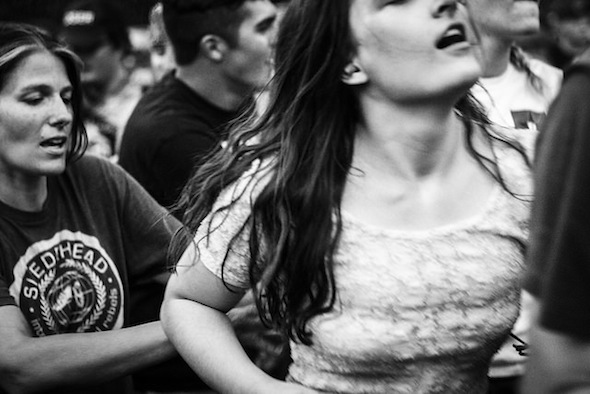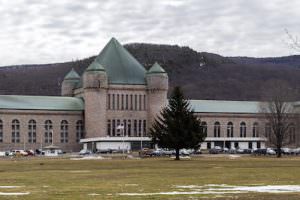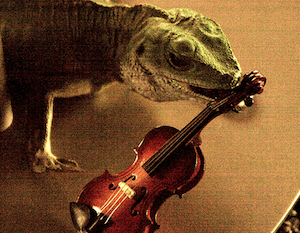Fighting (for) the Right to Party
The conventional left wisdom that music functions primarily as an occasion for the liberated expression of “collective joy” is all washed up. The carnivalesque spectacles are dead ends, channeling what might find political expression into narrowly personalized exercises in adolescent subjectivity.
This piece first appeared on John Halle’s website. It is a response to the N+1 issue 19 editorial, “The Concert Hall.”
When the left imagines the final expropriation of the expropriators, the soundtrack accompanying it might be folk, Motown, hip-hop, Ladysmith Black Mambazo, punk, Metallica, Fela Anikulapo Kuti, the Red Army Chorus, Bob Marley, Victor Jara, electronica or Crosby Still Nash and/or Young-all of these have been proposed at different times. Whatever we choose, it is a safe bet that it is not Beethoven string quartets or Bach trio sonatas.
Rather that is what the vile plutocrats themselves are listening to as the pitchfork wielding hordes mass outside of their bunkered compounds.
This is why, insofar as it is not seen as merely obtuse, expressing a preference for what is called classical, art or concert music over what used to be referred to as “popular” musical forms is viewed as potentially reactionary, an implicit defense of the privileged class which had financed the construction of the concert halls, hosted the salons, established systems of patronage and otherwise supported and promoted the art form over the generations.
In some of my recent articles I have tried to challenge or at least to add some nuance to this picture. I’m glad that the N+1 editors have taken notice and I’m also grateful that they have provided some subtle and erudite arguments agreeing with me that the conventional left wisdom on these matters is not as self-evident as is generally assumed.
Our agreement takes for granted several points of departure, among them the recognition that a dim view of musical high culture among the left is not a practical inevitability or a logical necessity. Indeed, as I argue in my piece “Nothing’s too Good for the Working Class” it is a relatively recent development. To take a few examples I cite there, in the past, one could assume some familiarity with what use to be called concert music warhorses such as Beethoven Symphonies, Mozart arias or Chopin Nocturnes, the basic themes of which would have been recognized by Marx or Lenin and are still by Stanley Aronowitz or Joel Kovel among others in their generational cohort. Similarly, while one rarely encounters classical music as a topic of conversation now, it was frequently at the IBEW Union Hall in Schenectady, NY, and at the ILGWU summer retreat Unity House. While few know the names of more than a two or three classical performers or composers this was not the case for what may have been hundreds or even thousands of students enrolled in music appreciation classes at the now forgotten but highly successful people’s schools sponsored by the Communist Party USA, including the Thomas Jefferson School for Social Science in New York City.
We also would probably agree that the left as it is now constituted would not regard this absence as something to despair-indeed they celebrate it. And they have some basis for their doing so, including that provided by Lawrence Levine’s influential Highbrow/Lowbrow, which depicts turn of the century elites developing the modern symphony orchestra and the codes of conduct associated with them as part of a broad effort to create appropriate habits of obedience, deference and respect for authority among a potentially restive working class. If classical music is finally dead, so the argument goes, we should be applauding just as much as we would the death of any other reactionary institution, whether it is the Heritage Foundation, the NRA or the Republican Party.
A third point of agreement is in recognizing that if the loss of authority and cultural prestige of the high arts and culture generally and classical music specifically is a defeat for social and political elites, it is an isolated and insignificant one: where it matters, their triumph is near total, with the 1% having managed to concentrate income share and wealth to a degree that would have been the envy of plutocrats of virtually any prior epoch. Along with this has been the near complete collapse of institutions by which the 99% had been able to exercise some degree of political influence, most notably unions as well other once powerful left wing constituencies both inside and outside the Democratic Party.
According to the logic assumed by the left, this is not what was not supposed to happen. Rather, the Dionysian energies of popular musical forms replacing the staid rituals of the concert hall were to be accompanied by analogous mass political movements overthrowing entrenched wealth, power and privilege and its accumulated social, cultural and economic capital. Alas, when the lights went on, it turned out the masses weren’t interested in pitch forks after all-the only right they were fighting for was the right to party. And they won. The codes of behavior associated with classical music are almost entirely reviled. As the N+1 editorial observes, almost everyone, including those who appreciate the music when it is experienced elsewhere, find the rituals of the concert hall oppressive at best–unbearable at worst.The question raised by observing this set of facts is whether there is more than a random, frivolous connection between the death of hope for a decently functioning and minimally just society and the perennial pearl clutching topic of “the death of classical music.” In responding to critics of my Jacobin article The Last Symphony, I’ve attempted to argue that there is, or, more precisely, that it should be seen in a broader context in which the left consoles itself for “the absence of substantive achievements,” by “tak(ing) refuge in symbolism”, or more precisely, confusing symbolic victories for substantive gains. Other examples along these lines include that
we have failed to make any difference in addressing the desperate conditions of indigenous peoples, but we have succeeded in changing of names of a couple of sports teams. We have done essentially nothing to prevent the largest drop in African American wealth in history over the past six years but we gladly take credit for and celebrate as one of our own the phenotypically African American president who presided over the carnage. A full one quarter of all African Americans rot in prison or on probation, but jazz (“black classical music”) has been granted a central place in music school curricula.
Shifting the analytical focus, the same logic applies to one of the few compensations we receive for suffering under the imposition of austerity economics: our hearing a faint echo of what were once thought to be “revolutionary” aspirations in the deluge of commercial musical product marketed to and willingly (or unwillingly) consumed by us.
I’ll have more to say about this, but before I do, it’s worth considering going beyond noting this connection, that is, considering whether there is an element of causality linking the embrace of the cultural and artistic legacy of aristocratic/haute bourgeois high culture of a prior left with its relative success and, conversely, the rejection of these with our comparative failure.
Excavating the matter a bit more deeply, the N+1 editors may be on to something when, via Proust’s creation of the imaginary composer Vinteuil in Swann’s Way, they note that Swann in
listen(ing) to the whole piece—at last experiences it from beginning to end—his thoughts are freed from the prison of his self-reflection. He understands that the music he heard was not, as he once thought, like a perfume, or a caress, or any other sensual accompaniment, but an idea and event of its own . . . The music exceeds the frameworks in which it’s performed—which banalize it, strive to render it unlistenable—and yet survives intact.
Of course, as someone whose daily labors consist of helping students develop the aural and analytical skills necessary to internalize the intricate, composed structure of canonic masterpieces, I am sympathetic to the possibility that these generalize to a larger capacity to view the world critically. And I’m even sympathetic to the view associated with Adorno that this species of critical engagement is in some sense analogous to that required to make sense of, and ultimately issue a fundamental challenge to, the underlying structural logic of capitalism.
But that’s not the argument which I want to make here. Rather what I’ll defend is the more easily supported complementary proposition, namely, that the conventional left wisdom on these questions–viewing music as functioning primarily as an occasion for the liberated expression of primal, unreflective “collective joy,” the subject of Barbara Ehrenreich’s Dancing in the Streets, is by now all washed up. Rather than being a transition to politicized forms of mass uprising, the carnivalesque spectacles are dead ends, channeling what might find expression through political channels into narrowly personalized exercises in adolescent subjectivity–hence the connection with Swann.
This explains why it is now many years since anything even vaguely resembling a critical left political content has been allowed anywhere near mass popular culture, something I can attest to as a parent of a nine year old still willingly immersing himself in the warm bath which it provides. Bearing in mind that, purely as music, popular music is neither better or worse than it ever has been, it is also readily apparent that a song dealing with the content of “The Lonesome Death of Hattie Carol”, “Four Dead in Ohio”, or “War: What is it Good For?” or even “Brother Can you Spare a Dime?” would never find its way past the corporate filters mediating the connection between musical production and mass consumption. Of course, as always, there is plenty of rebellion acted out in popular music, albeit in its most banal, adolescent, cynical and reactionary form of which the following is not atypical:
I got this feeling on the summer day when you were gone. I crashed my car into the bridge. I watched, I let it burn. I threw your shit into a bag and pushed it down the stairs. I crashed my car into the bridge.
I don’t care, I love it. I don’t care.
The notion that any kind of adversarial political culture will arise from popular music now seems a cruel joke-a mirror image of Swann’s trajectory from a critical awareness of objective musical content back into the most debased celebration of human subjectivity. Reduced to its barebones essence, what Swann learns from confronting the Vanteuil Sonata is that which teenagers (hopefully) learn when confronted with the pithy phrase “it’s not all about you.” Popular musical forms in their fully corporatized maturity serve as a high volume rejoinder to this recognition, smothering the expression of objective awareness, including that required for politicized mass action, constantly exhorting its targets to celebrate narcissistic self-absorption as the ne plus ultra of human experience.
At least, that is my opinion, one which I would not have been willing to advertise had it not been strongly reinforced by the dubious privilege of attending a live performance of the abovementioned contribution to the vocal music canon some weeks ago. It occurred, as it happens, in the context of a rock festival only a few miles from Woodstock, New York, just a few miles from the late Pete Seeger’s homestead. The Icono Pop duo, two comely young Swedes, took the stage inquiring of the mosh pit “How ya doing out there? Are you ready to party?” then proceeding to exhort their audience to “make some noise”, following it by a performance which, were it somewhat in-tune, would be indistinguishable from an aerobics routine. Unsurprisingly, this, compounded with high temperatures, lack of shade and a single water fountain servicing several thousands (bottled water was available-but for the extortionate price of $4.00),resulted in frequent calls to EMT crews to tend to sufferers of heat stroke. Kiosks representing loan refinancing, cosmetic dentistry, insurance company offices, car dealerships and, most conspicuously, recruitment outposts for all branches of the military service, lined the perimeter of the performance site. State Police, perfectly at home in this environment, threaded through the crowd scouring it for illegal substances, entirely unnecessary as a requirement for entry was submitting to a security patdown with anything other than a sealed eight ounce plastic water bottle subject to confiscation.
Suffice to say that Woody Guthrie, Country Joe Macdonald, John Lennon, or Gil Scott Heron would have soon discovered they had no business here, had they been allowed entry. As the truism goes, just we as individuals come to embody much of what we hated in our youth so too can the same be said of the legacy of the Woodstock generation in its hypercommercialized, reactionary dotage.
This, of course, raises the question of the new world waiting to be born, as the song goes. That is, what style or performance context will be able to articulate in musical terms the inevitable next wave-a tsunami, one hopes, of political dissent. I can’t say that I share the optimism of the N+1 editors that the ruins of the traditional classical canon be reconstructed to function as the foundation of the “fully enlightened human subjectivity” which they suggest it did in the past and can in the future. Nor am I optimistic, based on what I have heard, that works currently being composed within the remaining threads of what has become a stultifyingly self-aware art music tradition can sustain the level of engagement necessary for providing the necessary inspiration.
All that’s to say, as Tom Lehrer did about citizens of Pompeii, we should get used to crawling around in the rubble-both when it comes to political and musical culture. At the moment, while neither seems capable of supporting anything other than an increasingly decadent and unsustainable status quo, there is at least some basis for the hope that it will not always be thus.
John Halle is the director of studies in music theory and practice at Bard College.
Your support matters…Independent journalism is under threat and overshadowed by heavily funded mainstream media.
You can help level the playing field. Become a member.
Your tax-deductible contribution keeps us digging beneath the headlines to give you thought-provoking, investigative reporting and analysis that unearths what's really happening- without compromise.
Give today to support our courageous, independent journalists.




You need to be a supporter to comment.
There are currently no responses to this article.
Be the first to respond.